Process Optimization for Robotic Ultrasonic Strengthening of Aviation Blade Surfaces Based on Intelligent Compliance Control
Abstract
:1. Introduction
2. Compliant Control of Robotic Ultrasonic Surface Strengthening
3. Research on Intelligent Compliance Contact Force Control
3.1. Fuzzy PID Control of Contact Force
3.2. Fuzzy Controller Design
- (1).
- When the deviation (e) is relatively large, irrespective of the value of the error change (ec), the control quantity should be increased to eliminate the error.
- (2).
- When the deviation (e) is relatively small, to avoid excessive overshooting and to rapidly approach a steady state, the value of the deviation variation rate (ec) should be considered to adjust the control signal. If ec is positive, indicating an increasing trend in the deviation, the control quantity should be increased to prevent further error growth. If ec is negative, indicating a decreasing trend in the deviation, the control quantity can be set to a lower value, allowing the output signal to approach the desired setpoint.
- (1)
- If (e is NVB) and (ec is NVB), then (u is NVB);
- (2)
- If (e is NVB) and (ec is NB), then (u is NVB);
- ··· ··· ···
- (120)
- If (e is PVB) and (ec is PB), then (u is PVB);
- (121)
- If (e is PVB) and (ec is PVB), then (u is PVB).
3.3. Fuzzy PID Control Simulation of Contact Force
3.4. Experimental Verification of the Compliance Control Algorithm
4. Optimization Experiment Study on the Machining Parameters of Robotic Ultrasonic Surface Strengthening
4.1. Experimental Scheme of the Response Surface Design Method
4.2. Analysis of Surface Strengthening Quality
4.2.1. Surface Roughness Response Analysis
4.2.2. Surface Hardness Response Analysis
4.2.3. Response Optimization
5. Quality Evaluation of Robotic Ultrasonic Strengthening of Titanium Alloy Aviation Blades
6. Conclusions
- (1).
- The parallel fuzzy PID control method possesses the capability to eliminate steady-state error in the fuzzy control process, thereby enhancing the dynamic response performance of the end-effector system. The inclusion of the fuzzy link endows the system with robust adaptability and anti-interference ability, effectively suppressing system overshoot. Meanwhile, the PID link fulfills the role of accurately tracking the target value without static error. The compliance controller is adaptive and intelligent, and the regulation performance and tracking robustness of the system are improved. The compliance control strategy can realize the control optimization of the compliance device, thereby effectively improving the static and dynamic characteristics of the compliance control system.
- (2).
- The optimal combination of machining parameters of robotic ultrasonic surface strengthening is obtained from the RSM experiments. The experimental results indicate that appropriately increasing the levels of the three factors can enhance the surface quality of aviation blades. However, it is crucial to note that excessively high levels may lead to over-processing and consequent degradation in surface quality. Using response surface analysis, the interactive effects among various factors on surface strengthening performance are clearly demonstrated, providing valuable guidance for determining the optimal parameter range in actual strengthening processes.
- (3).
- The blade strengthening experiment verifies that the compliance control method can maintain the constant output of the contact force and significantly improve the surface quality of the blade. Table 3 shows the comparative data before and after strengthening. After robotic ultrasonic strengthening, the surface roughness of the blade is reduced from Ra 3.0 μm to about Ra 0.9 μm, and the surface hardness is increased from 582 HL to about 680 HL. The maximum residual compressive stress on the blade surface can reach 841 MPa, and the depth of the compressive stress layer is close to 1.2 mm. This compressive stress layer substantially enhances the wear resistance and fatigue resistance of the blade, consequently reducing fatigue-induced damage.
Author Contributions
Funding
Data Availability Statement
Conflicts of Interest
Appendix A
| Run | A | B | C | ΔRa (μm) | Hardness (HL) |
|---|---|---|---|---|---|
| 1 | −1 | −1 | −1 | 1.33135 | 648.522 |
| 2 | 1 | −1 | −1 | 1.37933 | 655.673 |
| 3 | −1 | 1 | −1 | 0.80361 | 629.671 |
| 4 | 1 | 1 | −1 | 1.61921 | 660.006 |
| 5 | −1 | −1 | 1 | 1.62784 | 648.231 |
| 6 | 1 | −1 | 1 | 1.74155 | 666.108 |
| 7 | −1 | 1 | 1 | 0.81914 | 630.042 |
| 8 | 1 | 1 | 1 | 1.33147 | 649.905 |
| 9 | −α | 0 | 0 | 0.61770 | 619.800 |
| 10 | α | 0 | 0 | 1.78113 | 666.507 |
| 11 | 0 | −α | 0 | 1.79912 | 670.840 |
| 12 | 0 | α | 0 | 1.33135 | 648.450 |
| 13 | 0 | 0 | −α | 1.67918 | 662.414 |
| 14 | 0 | 0 | α | 1.80524 | 672.222 |
| 15 | 0 | 0 | 0 | 1.98000 | 673.000 |
| 16 | 0 | 0 | 0 | 1.88908 | 670.840 |
| 17 | 0 | 0 | 0 | 1.78713 | 666.747 |
| 18 | 0 | 0 | 0 | 1.82311 | 668.192 |
| 19 | 0 | 0 | 0 | 1.79912 | 667.229 |

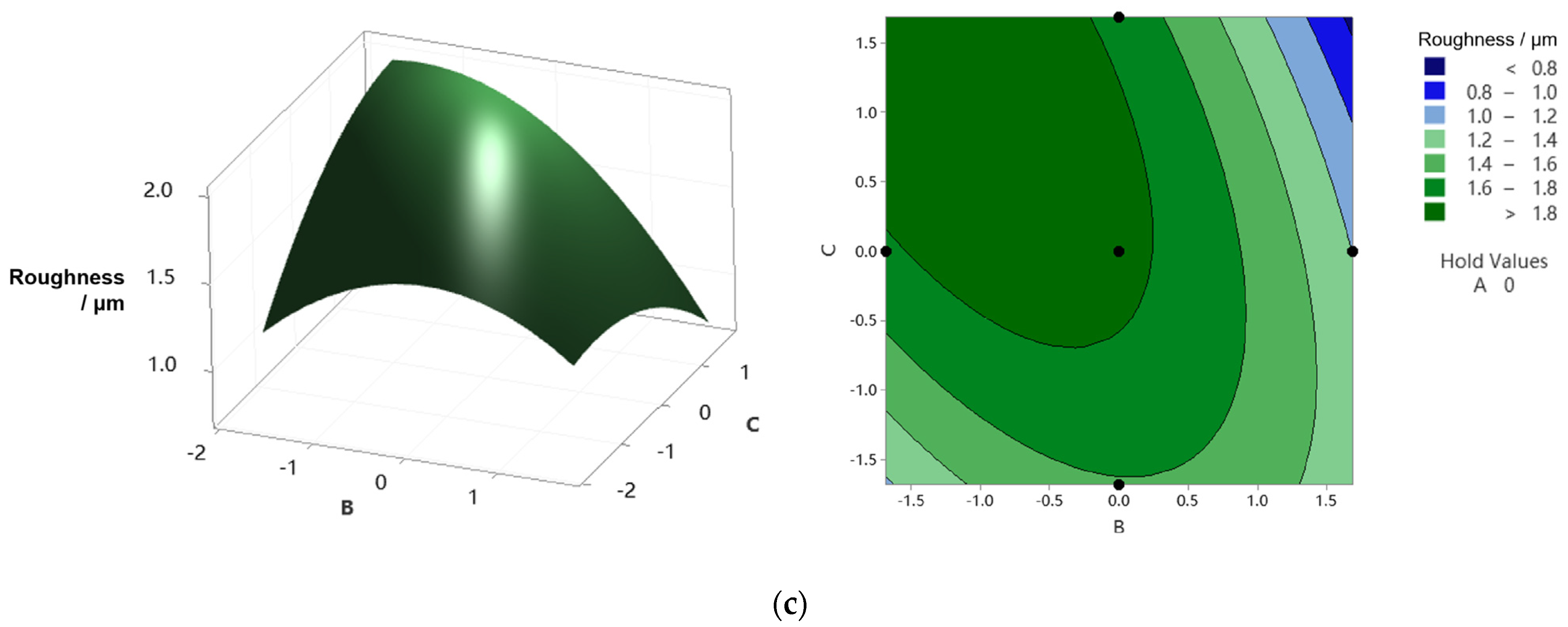
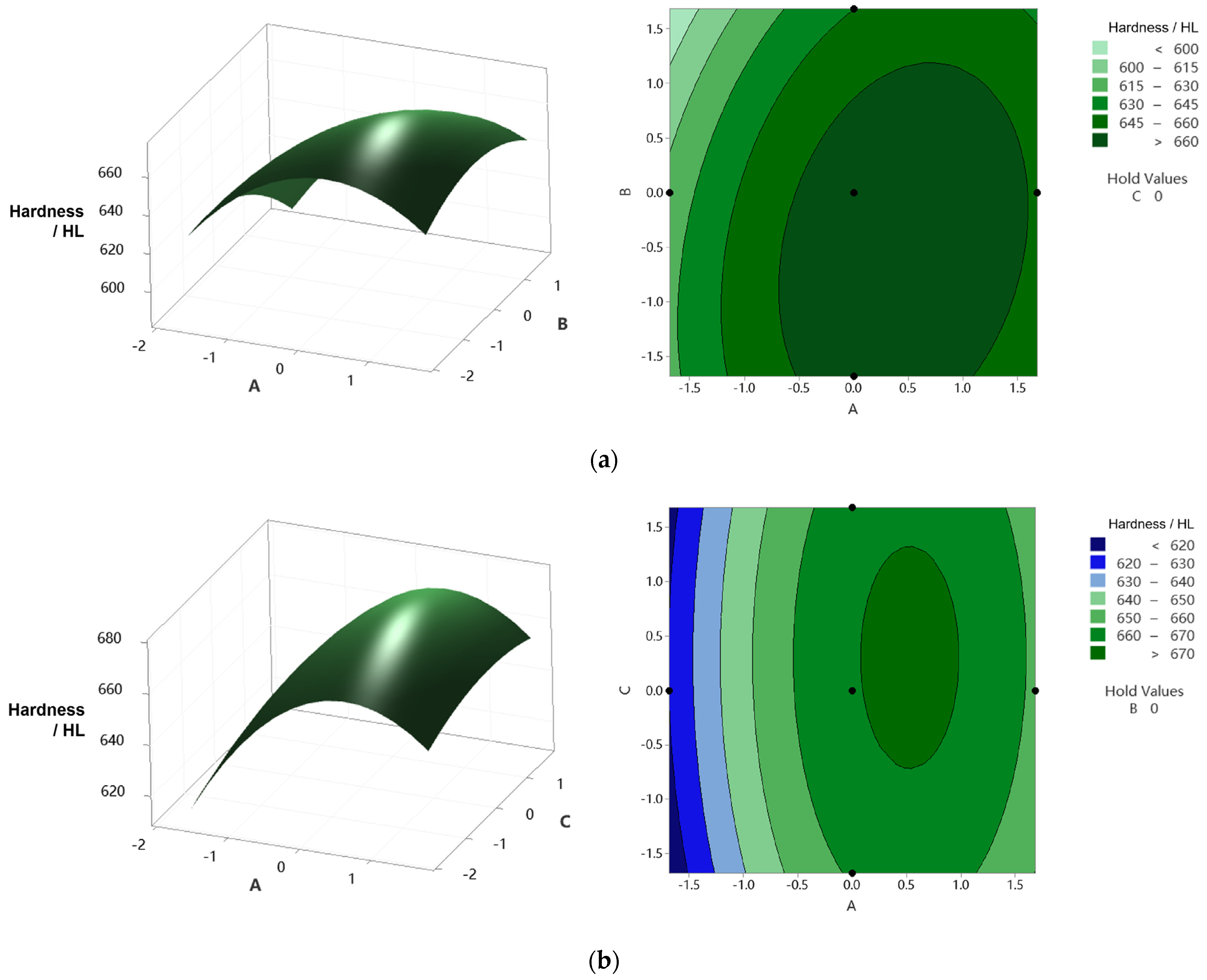
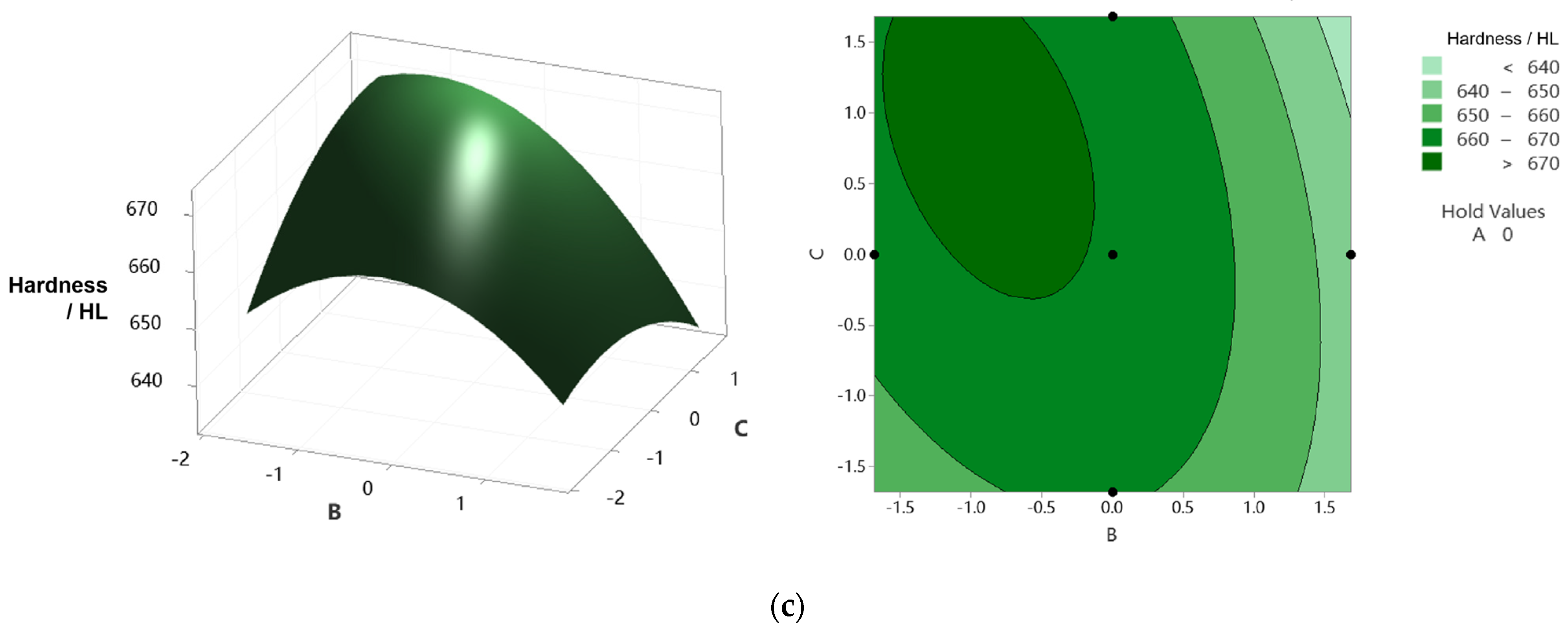
References
- Aust, J.; Pons, D. Taxonomy of gas turbine blade defects. Aerospace 2019, 6, 58. [Google Scholar] [CrossRef]
- Aust, J.; Pons, D. Methodology for evaluating risk of visual inspection tasks of aircraft engine blades. Aerospace 2021, 8, 117. [Google Scholar] [CrossRef]
- Li, J.; Wang, B.; Fang, S.; Chen, P. A new process chain combining cross-wedge rolling and isothermal forging for the forming of titanium alloy turbine blades. Int. J. Adv. Manuf. Technol. 2020, 108, 1827–1838. [Google Scholar] [CrossRef]
- Liu, F.; Chen, Y.; He, C.; Li, L.; Wang, C.; Li, H.; Zhang, H.; Wang, Q.; Liu, Y. Tensile and very high cycle fatigue behaviors of a compressor blade titanium alloy at room and high temperatures. Mat. Sci. Eng. A 2021, 811, 141049. [Google Scholar]
- Nie, X.; He, W.; Cao, Z.; Song, J.; Li, X.; Pang, Z.; Yan, X. Experimental study and fatigue life prediction on high cycle fatigue performance of laser-peened TC4 titanium alloy. Mat. Sci. Eng. A 2021, 822, 141658. [Google Scholar]
- Wu, J.; Che, Z.; Zou, S.; Cao, Z.; Sun, R. Surface integrity of TA19 notched simulated blades with laser shock peening and its effect on fatigue strength. J. Mater. Eng. Perform. 2020, 29, 5184–5194. [Google Scholar]
- Zou, S.; Wu, J.; Zhang, Y.; Gong, S.; Sun, G.; Ni, Z.; Cao, Z.; Che, Z.; Feng, A. Surface integrity and fatigue lives of Ti17 compressor blades subjected to laser shock peening with square spots. Surf. Coat. Technol. 2018, 347, 398–406. [Google Scholar]
- Optasanu, V.; de Lucas, M.C.M.; Kanjer, A.; Vincent, B.; Montesin, T.; Lavisse, L. high temperature oxidation kinetics of shot-peened and laser-shock peened Ti-Beta-21S. Oxid. Met. 2021, 96, 257–270. [Google Scholar] [CrossRef]
- Unal, O.; Maleki, E.; Karademir, I.; Husem, F.; Efe, Y.; Das, T. Effects of conventional shot peening, severe shot peening, re-shot peening and precised grinding operations on fatigue performance of AISI 1050 railway axle steel. Int. J. Fatigue 2022, 155, 106613. [Google Scholar]
- Rodríguez, A.; González, M.; Pereira, O.; de Lacalle, L.N.L.; Esparta, M. Edge finishing of large turbine casings using defined multi-edge and abrasive tools in automated cells. Int. J. Adv. Manuf. Technol. 2023, 124, 3149–3159. [Google Scholar] [CrossRef]
- Fang, S.; Zhang, Q.; Zhao, H.; Yu, J.; Chu, Y. The design of rare-earth giant magnetostrictive ultrasonic transducer and experimental study on its application of ultrasonic surface strengthening. Micromachines 2018, 9, 98. [Google Scholar] [CrossRef] [PubMed]
- Zhu, L.; Gong, C.; Zhang, C.; Qian, J.; Liu, S.; Zhang, X.; Liu, C. Robot-assisted ultrasonic impact strengthening strategy for aero-engine blades. Robot. Comput.-Integr. Manuf. 2022, 78, 102389. [Google Scholar]
- Fang, S.; Zhang, Q.; Cheng, W.; Wang, J.; Liu, C.; Han, K. Research on path planning of robotic ultrasonic surface strengthening for turbine blade based on dynamic response of ultrasonic surface strengthening. Adv. Mech. Eng. 2019, 11, 3. [Google Scholar]
- Kheradmandfard, M.; Kashani-Bozorg, S.F.; Kang, K.H.; Penkov, O.V.; Zarei Hanzaki, A.; Pyoun, Y.S.; Amanov, A.; Kim, D.E. Simultaneous grain refinement and nanoscale spinodal decomposition of β phase in Ti-Nb-Ta-Zr alloy induced by ultrasonic mechanical impacts. J. Alloys Compd. 2018, 738, 540–549. [Google Scholar]
- Panin, A.; Dmitriev, A.; Nikonov, A.; Kazachenok, M.; Perevalova, O.; Sklyarova, E. Transformations of the microstructure and phase compositions of titanium alloys during ultrasonic impact treatment. Part i. commercially pure titanium. Metals 2021, 11, 562. [Google Scholar] [CrossRef]
- Yen, V.; Nan, W.; Van, C. Recurrent fuzzy wavelet neural networks based on robust adaptive sliding mode control for industrial robot manipulators. Neural Comput. Appl. 2019, 31, 6945–6958. [Google Scholar]
- Narayanan, V.; Jagannathan, S.; Ramkumar, K. Event-Sampled Output Feedback Control of Robot Manipulators Using Neural Networks. IEEE Trans. Neural Netw. Learn. Syst. 2019, 30, 1651–1658. [Google Scholar] [CrossRef]
- Quynh, N.; Nan, W.; Yen, V. Design of a robust adaptive sliding mode control using recurrent fuzzy wavelet functional link neural networks for industrial robot manipulator with dead zone. Intell. Serv. Robot. 2020, 13, 219–233. [Google Scholar]
- Vu, M.; Alattas, K.; Bouteraa, Y.; Rahmani, R.; Fekih, A.; Mobayen, S. Optimized Fuzzy Enhanced Robust Control Design for a Stewart Parallel Robot. Mathematics 2022, 10, 1917. [Google Scholar] [CrossRef]
- Zheng, K.; Hu, Y.; Wu, B. Intelligent fuzzy sliding mode control for complex robot system with disturbances. Eur. J. Control 2020, 51, 95–109. [Google Scholar]
- Wen, S.H.; Zheng, W.; Jia, S.D.; Ji, Z.X.; Hao, P.C.; Lam, H.K. Unactuated force control of 5-DOF parallel robot based on fuzzy PI. Int. J. Control Autom. Syst. 2020, 18, 1629–1641. [Google Scholar]
- Li, K.; He, Y.; Li, K.; Liu, C. Adaptive fractional-order admittance control for force tracking in highly dynamic unknown environments. Ind. Robot. 2023, 50, 530–541. [Google Scholar]
- Yilmaz, B.M.; Tatlicioglu, E.; Savran, A.; Alci, M. Adaptive fuzzy logic with self-tuned membership functions based repetitive learning control of robotic manipulators. Appl. Soft Comput. 2021, 104, 107183. [Google Scholar]
- Huynh, B.P.; Kuo, Y.L. Optimal fuzzy impedance control for a robot gripper using gradient descent iterative learning control in fuzzy rule base design. Appl. Sci. 2020, 10, 3821. [Google Scholar] [CrossRef]
- Joshi, K.; Melkote, S.N.; Anderson, M.; Chaudhari, R. Investigation of cycle time behavior in the robotic grinding process. CIRP J. Manuf. Sci. Technol. 2021, 35, 315–322. [Google Scholar]
- Zaeh, M.F.; Schnoes, F.; Obst, B.; Hartmann, D. Combined offline simulation and online adaptation approach for the accuracy improvement of milling robots. CIRP Ann. 2020, 69, 337–340. [Google Scholar]
- Jiang, Z.; Qi, X.; Sun, Y.; Hu, Y.; Zahnd, G.; Zhang, J. Cutting depth monitoring based on milling force for robot-assisted laminectomy. IEEE Trans. Autom. Sci. Eng. 2020, 17, 2–14. [Google Scholar]
- Gaz, C.; Magrini, E.; de Luca, A. A model-based residual approach for human-robot collaboration during manual polishing operations. Mechatronics 2018, 55, 234–247. [Google Scholar]
- Ochoa, H.; Cortesão, R. Impedance control architecture for robotic-assisted mold polishing based on human demonstration. IEEE Trans. Ind. Electron. 2022, 69, 3822–3830. [Google Scholar] [CrossRef]
- Kumar, N.; Panwar, V.; Sukavanam, N.; Sharma, S.P.; Borm, J.H. Neural network based hybrid force/position control for robot manipulators. Int. J. Precis. Eng. Man. 2011, 12, 419–426. [Google Scholar]
- Ma, Z.; Poo, A.N.; Ang, M.H.; Hong, G.S.; See, H.H. Design and Control of an End-Effector for Industrial Finishing Applications. Robot. Comput.-Integr. Manuf. 2018, 53, 240–253. [Google Scholar]
- Cao, G.; Zhao, X.; Ye, C.; Yu, S.; Li, B.; Jiang, C. Fuzzy adaptive PID control method for multi-mecanum-wheeled mobile robot. J. Mech. Sci. Technol. 2022, 36, 2019–2029. [Google Scholar] [CrossRef]
- Sukpancharoen, S.; Hansirisawat, P.; Srinophakun, T.R. Implementation of response surface to optimum biodiesel power plant derived from empty fruit bunch. J. Energy Resour. Technol. 2022, 144, 012101. [Google Scholar] [CrossRef]
- Tamilarasan, U.; Dhanasekar, S.; Raja Karthikeyan, K.; Ramesh Babu, T.S.; Gopinathan, R.; Pratheep, V.G.; Rajalakshmy, P.; Subbiah, R.; Praveen Kumar, S. Study of mechanical properties on ferric oxide microparticles reinforced with polyethylene. Adv. Mater. Sci. Eng. 2022, 2022, 3077301. [Google Scholar] [CrossRef]
- Yong, Z.; Chang, L.; Jiang, S.; Xie, D.; Xing, F.; Shen, H.; Shen, L.; Tian, Z. Parameter optimization of T800 coating fabricated by EHLA based on response surface methodology. Opt. Laser Technol. 2023, 158, 108837. [Google Scholar] [CrossRef]
- Alagarsamy, S.V.; Ravichandran, M.; Sakthivelu, S.; Kumar, S.D.; Meignanamoorthy, M. Optimization of electric discharge machining parameters on surface roughness for Al/ZrO2 composite through response surface methodology. Mater. Today Proc. 2020, 27, 1006–1012. [Google Scholar] [CrossRef]
- Shi, Y.; Li, C.; Huang, Y. Resonance suppression of a controllable mechanism welding robot end with central composite design methodology. Appl. Sci. 2022, 12, 6352. [Google Scholar] [CrossRef]
- Wang, D.; Xu, S.; Li, Z.; Cao, W. Analysis of the influence of parameters of a spraying system designed for UAV application on the spraying quality based on Box–Behnken response surface method. Agriculture 2022, 12, 131. [Google Scholar] [CrossRef]
- Ma, J.; Li, Y.; Zhang, D.; Zhao, B.; Wang, G.; Pang, X. Dynamic response prediction model of thin-wall workpiece-fixture system with magnetorheological damping in milling. J. Manuf. Process 2022, 74, 500–510. [Google Scholar] [CrossRef]
- Hou, J.; Zhao, Z.; Fu, Y.; Qian, N. Machining stability enhancement in multi-axis milling of titanium hollow blade by introducing multiple damping and rigid supporters. J. Manuf. Process 2021, 64, 198–208. [Google Scholar]

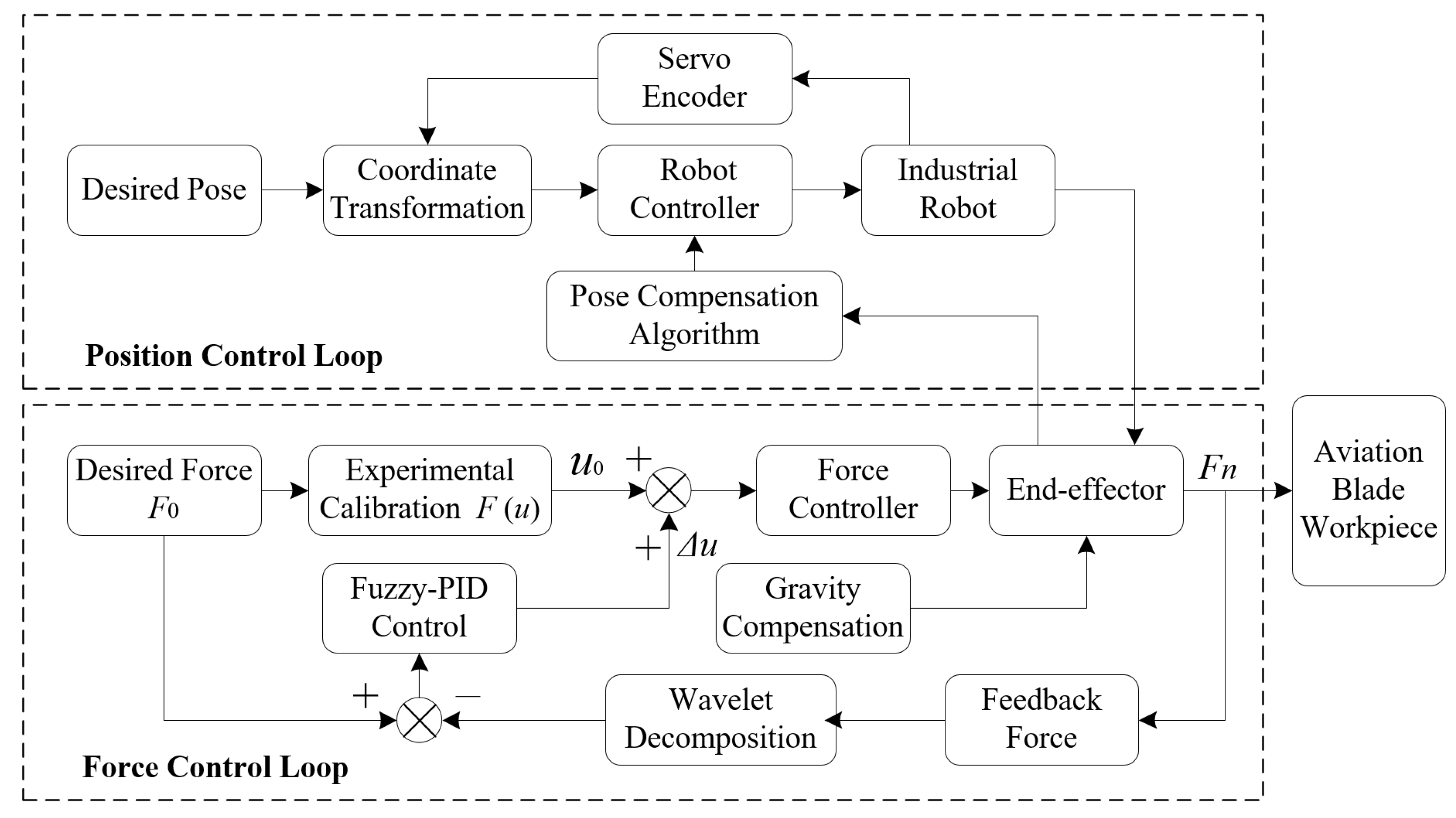
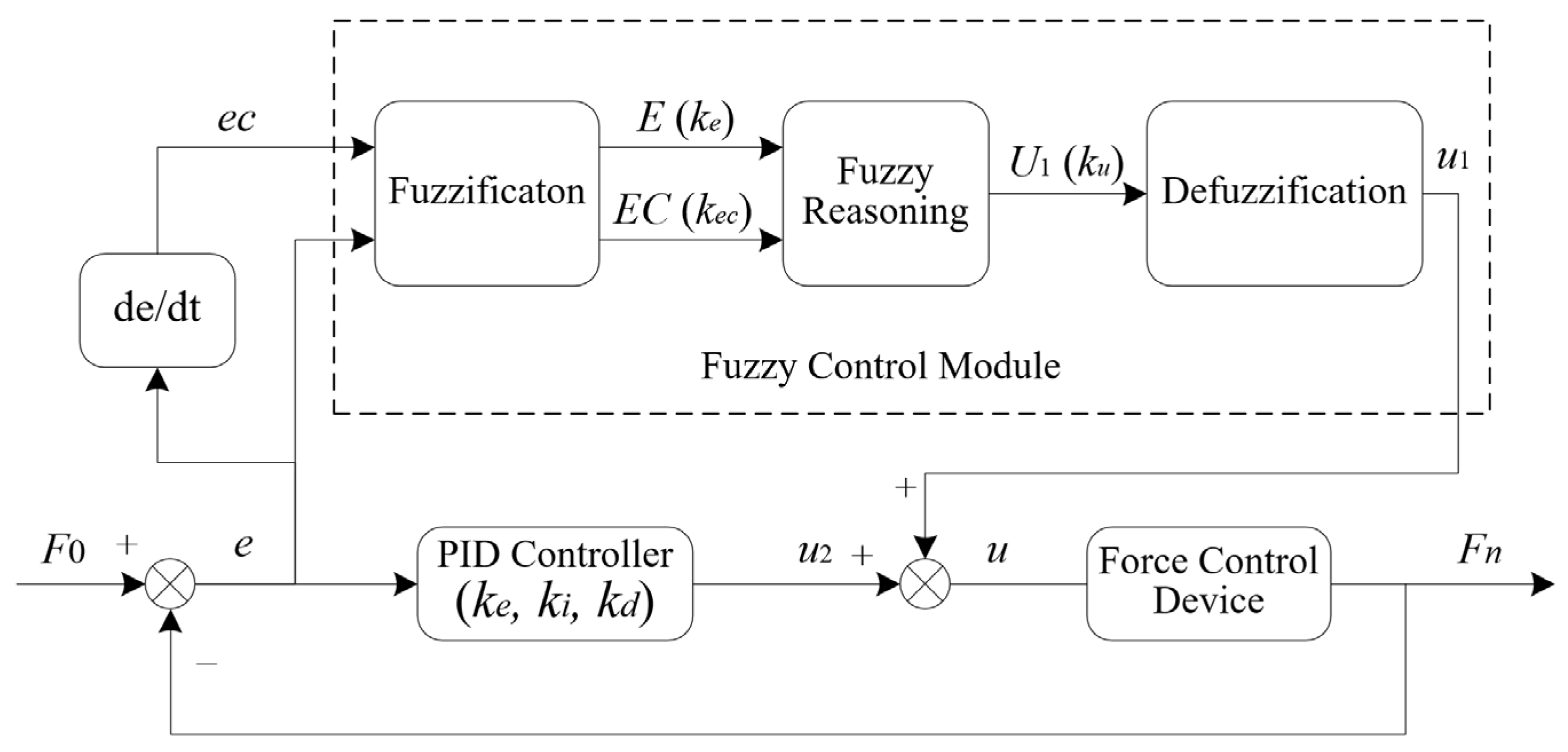
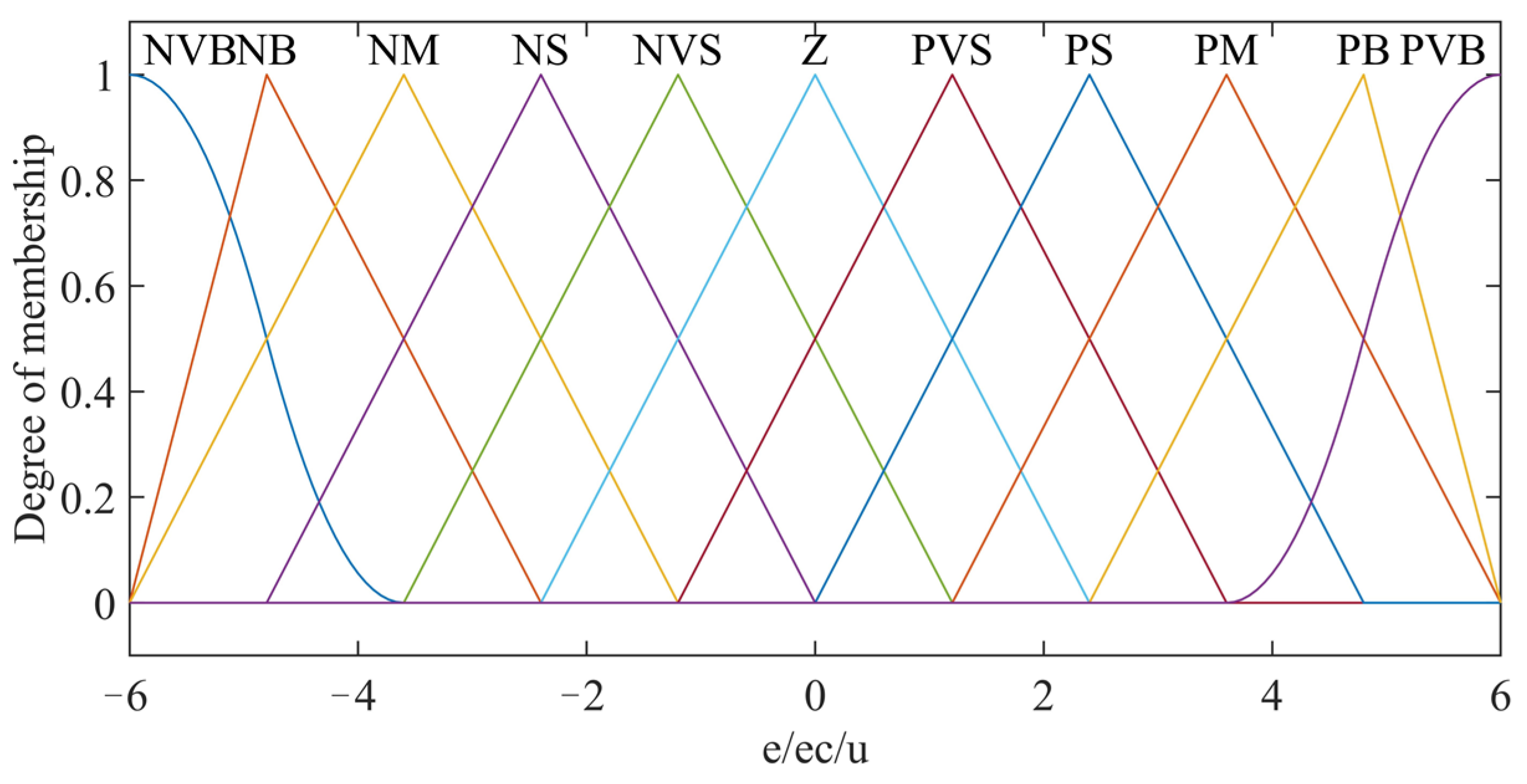

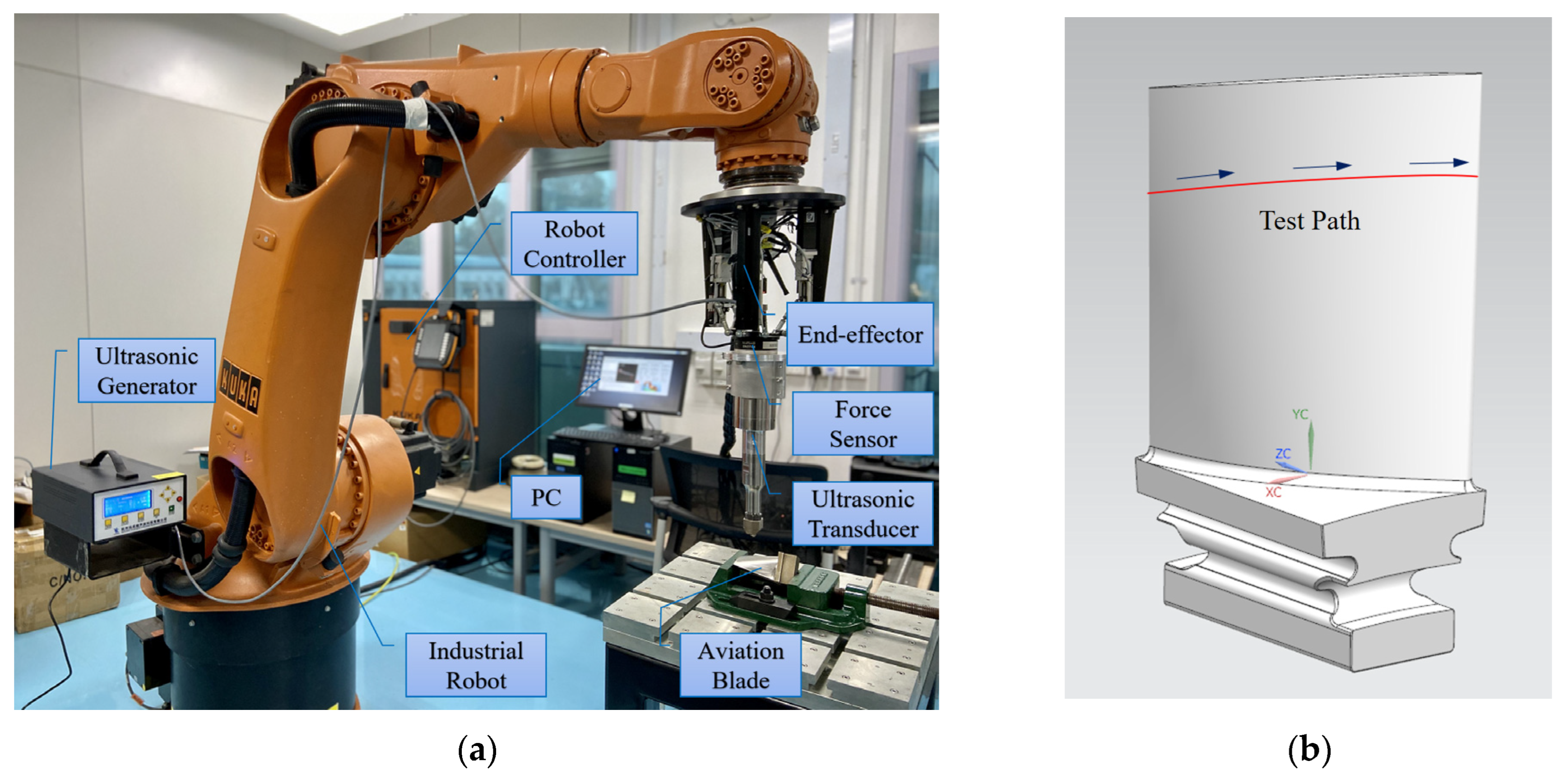


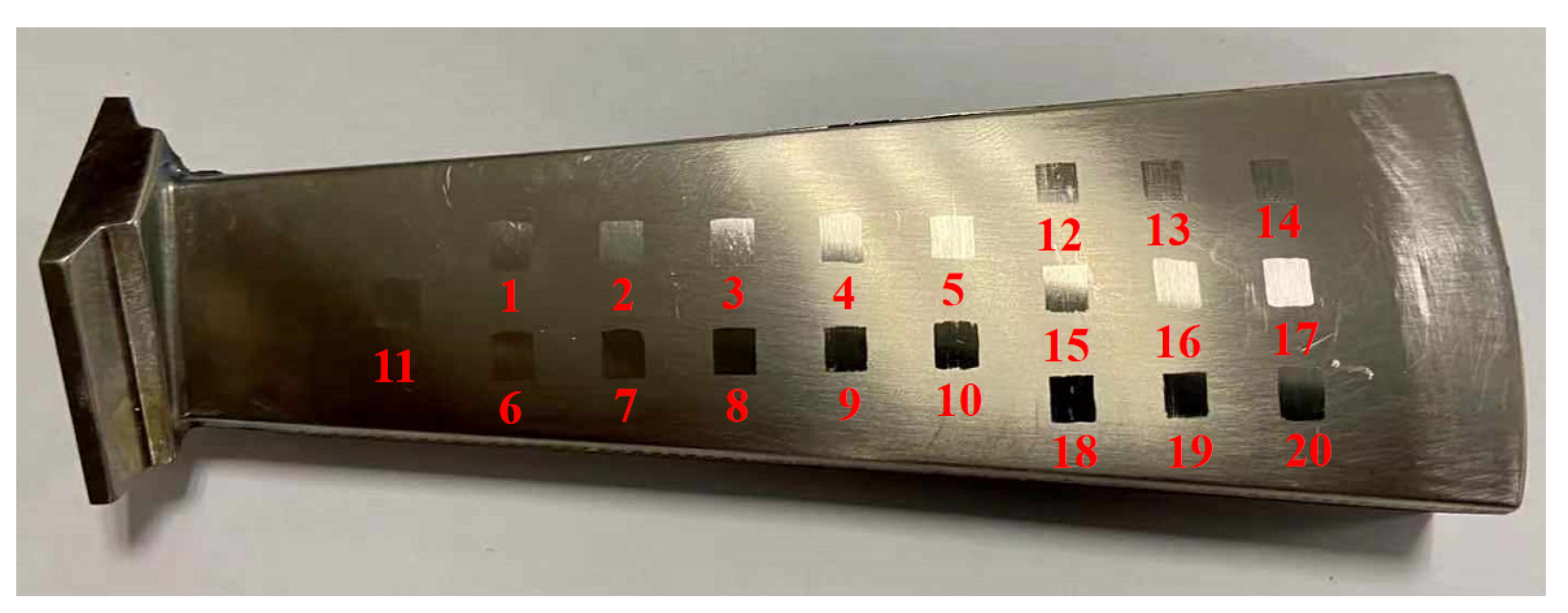
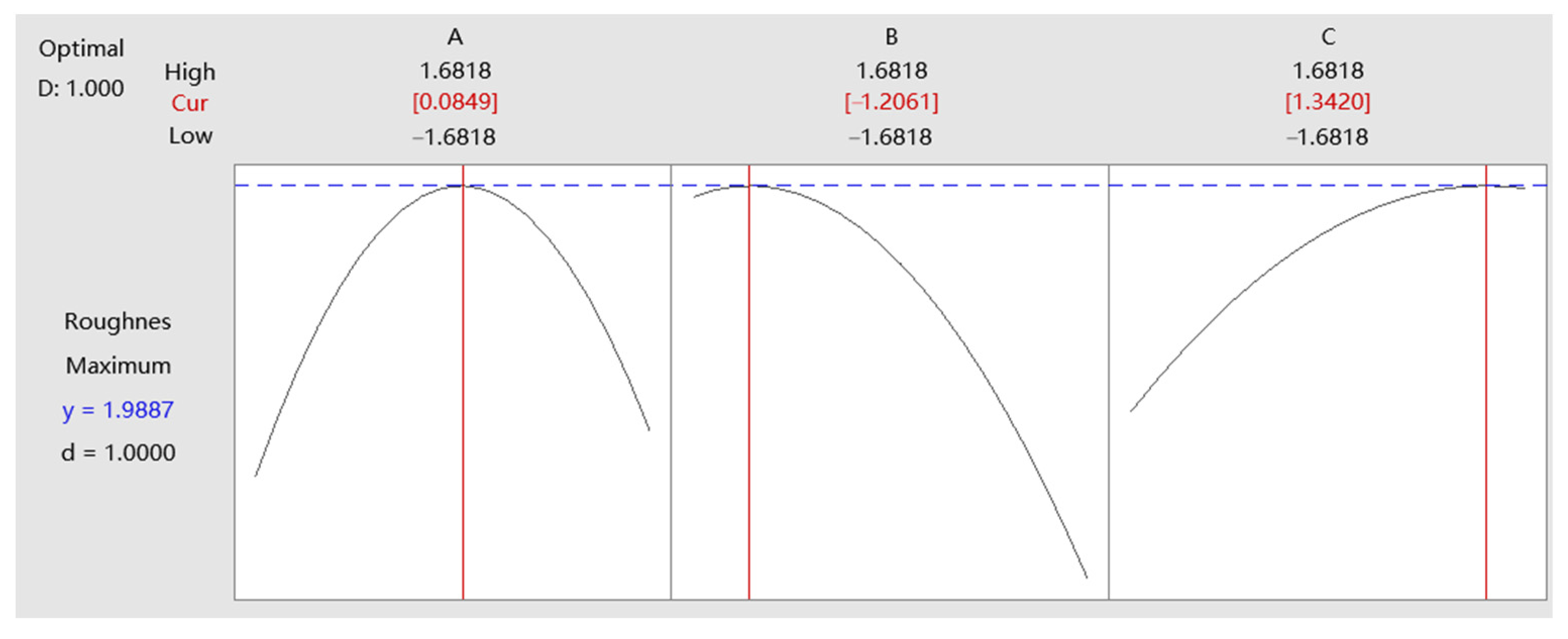



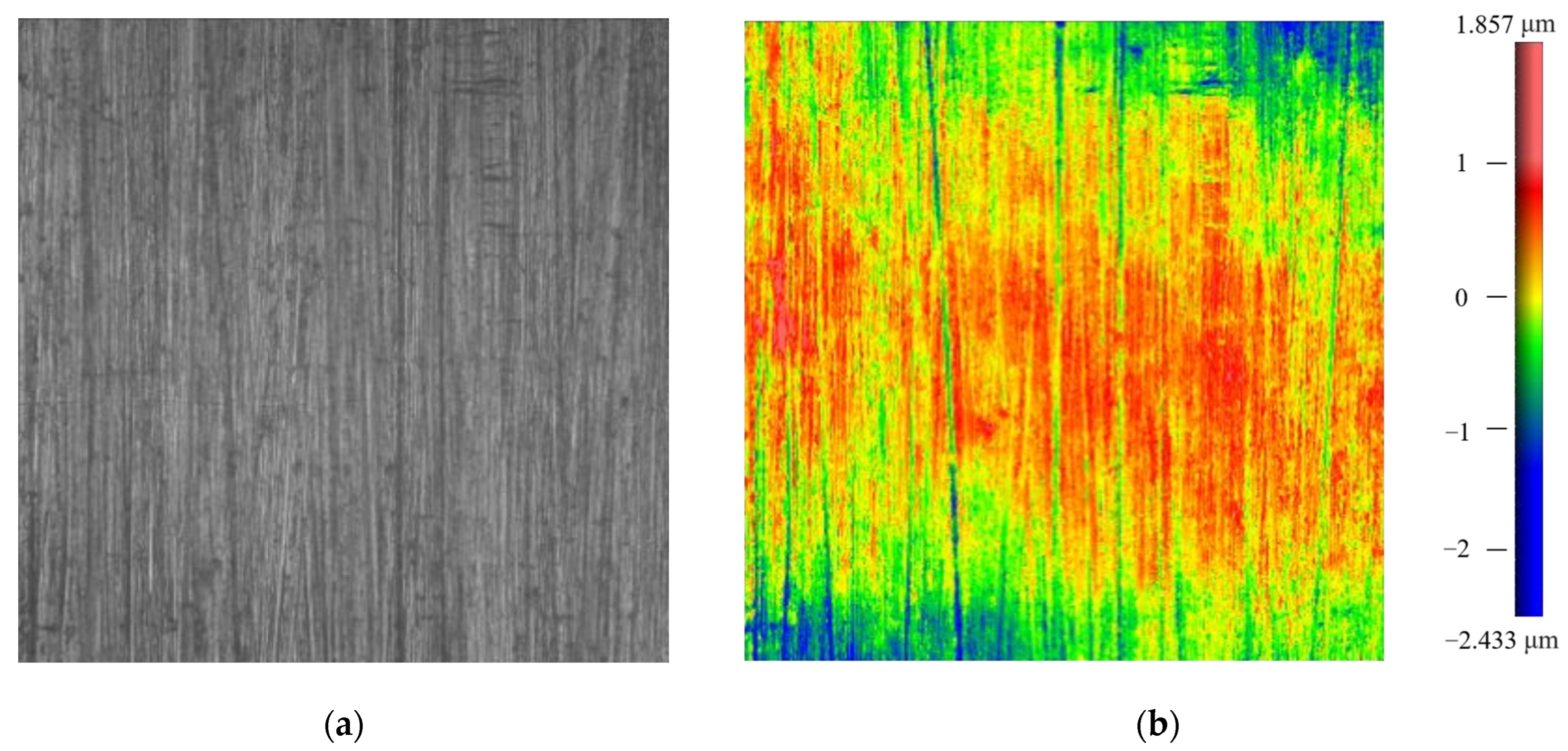

| Fuzzy Control Rule Table | ||||||||||||
|---|---|---|---|---|---|---|---|---|---|---|---|---|
| u | e | |||||||||||
| NVB | NB | NM | NS | NVS | ZO | PVS | PS | PM | PB | PVB | ||
| ec | NVB | NVB | NVB | NB | NB | NM | NM | NS | NS | NVS | NVS | ZO |
| NB | NVB | NB | NB | NM | NM | NS | NS | NVS | NVS | ZO | PVS | |
| NM | NB | NB | NM | NM | NS | NS | NVS | NVS | ZO | PVS | PVS | |
| NS | NB | NM | NM | NS | NS | NVS | NVS | ZO | PVS | PVS | PS | |
| NVS | NM | NM | NS | NS | NVS | NVS | ZO | PVS | PVS | PS | PS | |
| ZO | NM | NS | NS | NVS | NVS | ZO | PVS | PVS | PS | PS | PM | |
| PVS | NS | NS | NVS | NVS | ZO | PVS | PVS | PS | PS | PM | PM | |
| PS | NS | NVS | NVS | ZO | PVS | PVS | PS | PS | PM | PM | PB | |
| PM | NVS | NVS | ZO | PVS | PVS | PS | PS | PM | PM | PB | PB | |
| PB | NVS | ZO | PVS | PVS | PS | PS | PM | PM | PB | PB | PVB | |
| PVB | ZO | PVS | PVS | PS | PS | PM | PM | PB | PB | PVB | PVB | |
| Factor | Coded Symbol | Unit | Factor Level | ||||
|---|---|---|---|---|---|---|---|
| −α | −1 | 0 | 1 | +α | |||
| Contact force | A | N | 16.6 | 20 | 25 | 30 | 33.4 |
| Feed rate | B | mm/s | 1.16 | 1.5 | 2 | 2.5 | 2.84 |
| Repetitions | C | \ | 1 | 2 | 3 | 4 | 5 |
| Surface Roughness | Surface Hardness | Maximum Residual Compressive Stress | Compressive Stress Layer | |
|---|---|---|---|---|
| Before RUSS | Ra 3.0 μm | 582 HL | \ | \ |
| After RUSS | Ra 0.9 μm | 680 HL | 841 MPa | 1.2 mm |
Disclaimer/Publisher’s Note: The statements, opinions and data contained in all publications are solely those of the individual author(s) and contributor(s) and not of MDPI and/or the editor(s). MDPI and/or the editor(s) disclaim responsibility for any injury to people or property resulting from any ideas, methods, instructions or products referred to in the content. |
© 2023 by the authors. Licensee MDPI, Basel, Switzerland. This article is an open access article distributed under the terms and conditions of the Creative Commons Attribution (CC BY) license (https://creativecommons.org/licenses/by/4.0/).
Share and Cite
Fang, S.; Zhu, Y.; Zhang, Q.; Zhang, Y. Process Optimization for Robotic Ultrasonic Strengthening of Aviation Blade Surfaces Based on Intelligent Compliance Control. Micromachines 2023, 14, 1920. https://doi.org/10.3390/mi14101920
Fang S, Zhu Y, Zhang Q, Zhang Y. Process Optimization for Robotic Ultrasonic Strengthening of Aviation Blade Surfaces Based on Intelligent Compliance Control. Micromachines. 2023; 14(10):1920. https://doi.org/10.3390/mi14101920
Chicago/Turabian StyleFang, Shanxiang, Yukai Zhu, Qinjian Zhang, and Yong Zhang. 2023. "Process Optimization for Robotic Ultrasonic Strengthening of Aviation Blade Surfaces Based on Intelligent Compliance Control" Micromachines 14, no. 10: 1920. https://doi.org/10.3390/mi14101920





